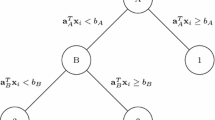Abstract
This paper develops a branch-and-bound method based on a new convex reformulation to solve the high order MIMO detection problem. First, we transform the original problem into a \(\{-1,1\}\) constrained quadratic programming problem with the smallest size. The size of the reformulated problem is smaller than those problems derived by some traditional transformation methods. Then, we propose a new convex reformulation which gets the maximized average objective value as the lower bound estimator in the branch-and-bound scheme. This estimator balances very well between effectiveness and computational cost. Thus, the branch-and-bound algorithm achieves a high total efficiency. Several simulations are used to compare the performances of our method and other benchmark methods. The results show that this proposed algorithm is very competitive for high accuracy and relatively good efficiency.




Similar content being viewed by others
References
Billionnet A, Elloumi S (2007) Using a mixed integer quadratic programming solver for the unconstrained quadratic 0–1 problem. Math Program 109:55–68
Bunse-Gerstner A, Kubaliń D, Vossen G, Wilczek D (2010) \(h_2\)-norm optimal model reduction for large scale discrete dynamical MIMO systems. J Comput Appl Math 233:1202–1216
Damen M, El Gamal H, Caire G (2003) On maximum-likelihood detection and the search for the closest lattice point. IEEE Trans Inf Theory 49:2389–2402
Fincke U, Pohst M (1985) Improved methods for calculating vectors of short length in a lattice, including a complexity analysis. Math Computat 44:463–471
El Gamal H, Caire G, Damen M (2004) Lattice coding and decoding achieve the optimal diversity-multiplexing tradeoff of MIMO channels. IEEE Trans Inf Theory 50:968–985
Goldberger J, Leshem A (2011) MIMO detection for high-order QAM based on a Gaussian tree approximation. IEEE Trans Inf Theory 57:4973–4982
Grant M, Boyd S (2010) CVX: matlab Software for Disciplined Programming. Version 1.2. http://cvxr.com/cvx
Jaldén J, Elia P (2010) DMT optimality of LR-aided linear decoders for a general class of channels, lattice designs, and system models. IEEE Trans Inf Theory 56:4765–4780
Jaldén J, Ottersten B (2005) On the complexity of sphere decoding in digital communications. IEEE Trans Signal Process 53:1474–1484
Kisialiou M, Luo Z (2005) Performance Analysis of Quasi-Maximum-Likelihood Detector Based on Semidefinite Programming. In: Proceedings of the IEEE International Conference on Acoustics Speech and Signal Process, vol III, pp 433–436
Liu S, Ling C, Stehlé D (2011) Decoding by sampling: A randomized lattice algorithm for bounded-distance decoding. IEEE Trans Inf Theory 57:5933–5945
Lu C, Guo X (2015) Convex reformulation for binary quadratic programming problems via average objective value maximization. Optim Lett 9:523–535
Luzzi L, Stehlé D, Ling C (2013) Decoding by embedding: Correct decoding radius and DMT optimality. IEEE Trans Inf Theory 59:960–2973
Ma W, Davidson T, Wong K, Ching P (2004) A block alternating likelihood maximization approach to multiuser detection. IEEE Trans Signal Process 52:2600–2611
Ma W, Su C, Jaldém J, Chang T, Chi C (2009) The equivalence of semidefinite relaxation MIMO detectors for higher-order QAM. IEEE J Select Top Signal Process 3:1038–1052
Mao Z, Wang X, Wang X (2007) Semidefinite programming relaxation approach for multiuser detection of QAM signals. IEEE Trans Wire Commun 6:4275–4279
Pan J, Ma W, Jaldém J (2014) MIMO detection by Lagrangian dual maximum-likilihood relaxation: Reinterpreting regularized lattice decoding. IEEE Trans Signal Process 62:511–524
Pardalos P, Rodgers G (1990) Computational aspects of a branch and bound algorithm for quadratic zero-one programming. Computing 45:131–144
Sidiropoulos N, Luo Z (2006) A semidefinite relaxation approach to MIMO detection for higher-order constellations. IEEE Signal Process lett 13:525–528
Singh A, Elia P, Jaldén J (2012) Achieving a vanishing SNR gap to exact lattice decoding at a subexponential complexity. IEEE Trans Inf Theory 58:3692–3707
Taherzadeh M, Khandani A (2010) On the limitations of the naive lattice decoding. IEEE Trans Inf Theory 56:4820–4826
Tan P, Rasmussen L (2001) The application of semidefinite programming for detection in CDMA. IEEE J Select Areas Commun 19:1442–1449
Tian Y, Dang JF (2015) MIMO detection for high order QAM by canonical dual approach. J Appl Math. doi:10.1155/2015/201369
Tse D, Viswanath P (2005) Fundamentals of wireless communication. Cambridge University Press, Cambridge
Vandenberghe L, Boyd S (1996) Semidefinite programming. SIAM Rev 38:49–95
Verdú S (1998) Multiuser detectection. Cambridge University Press, Cambridge
Viterbo E, Boutros J (1999) A universal lattice code decoder for fading channels. IEEE Trans Inform Theory 45:1639–1642
Wang Z, Fang SC, Gao D, Xing W (2008) Global extremal conditions for multi-integer quadratic programming. J Ind Manage Optim 4:213–225
Wiesel A, Eldar Y, Shamai S (2005) Semidefinite relaxation for detection of 16-QAM signaling in MIMO channels. IEEE Signal Process Lett 13:525–528
Wübben D, Seethaler D, Jaldén J, Matz G (2011) Lattice reduction. IEEE Signal Process Mag 28:70–91
Acknowledgments
Tian’s research has been supported by the Chinese National Science Foundation \(\# 11401485\) and \(\# 71331004\).
Author information
Authors and Affiliations
Corresponding author
Rights and permissions
About this article
Cite this article
Tian, Y., Li, K., Yang, W. et al. A new effective branch-and-bound algorithm to the high order MIMO detection problem. J Comb Optim 33, 1395–1410 (2017). https://doi.org/10.1007/s10878-016-0045-5
Published:
Issue Date:
DOI: https://doi.org/10.1007/s10878-016-0045-5




